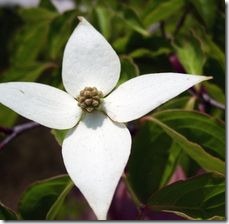The starlight flowering dogwood tree is the result of breeding a Kousa dogwood, Cornus kousa, with a Pacific dogwood, Cornus nuttallii. This winter-hardy dogwood variety is also known for being disease-resistant. The lovely blossoms of the starlight flowering dogwood cause birds, bees and butterflies to flock, making the tree even more appealing to wildlife lovers.
Features
-
Starlight flowering dogwoods can grow to a height between 20 and 30 feet with spreads that can reach over 20 feet in diameter. According to Rutgers University, the white blossoms can have a slightly greenish tinge and are actually bracts (similar to the "flowers" of poinsettia plants) that can grow between 4 and 5 inches. The tips of the blossoms are pointier, whereas other varieties of dogwood trees have blossoms with tips that are more rounded. In the fall, starlight flowering dogwoods produce fruit that look a lot like strawberries.
Growing Requirements
-
The starlight will grow in USDA zones 6a to 8b, however, in the warmer regions it is important to ensure that the tree receives plenty of shade (dogwoods prefer partial shade even in the cooler regions). Although dogwoods can tolerate many soil types, nutrient-rich, slightly acidic soil that drains well helps develop a strong and healthy tree.
Planting
-
Dig a hole that is approximately three times the diameter of the root ball and plant the tree so that it remains just slightly above soil level. Carefully fill in the space on the sides of the root ball with the original soil or a mixture of the original soil and some organic matter. Apply a layer of mulch about 2 inches out from the trunk of the tree and water well.
Care
-
Water regularly until the tree has been established. Dogwood trees’ soil should remain moist (but should not sit in a pool of water), usually requiring watering one to two times a week. Unless you have poor soil quality you should not have to add fertilizer. Pruning is generally only needed to create a desired shape.
Problems
-
According to Rutgers University there have been no insect or disease problems in the 30 years since the original hybrid tree was planted. There are many varieties of dogwood trees that fall prey to anthracnose and powdery mildew, but starlights are known for being generally problem-free. They are even known for being able to withstand drought fairly well, another plus that is mainly unique to starlights.


Deprecated: strpos(): Passing null to parameter #1 ($haystack) of type string is deprecated in /home/agriviek8Qv/agriviet.net/public_html/wp-includes/comment-template.php on line 2522